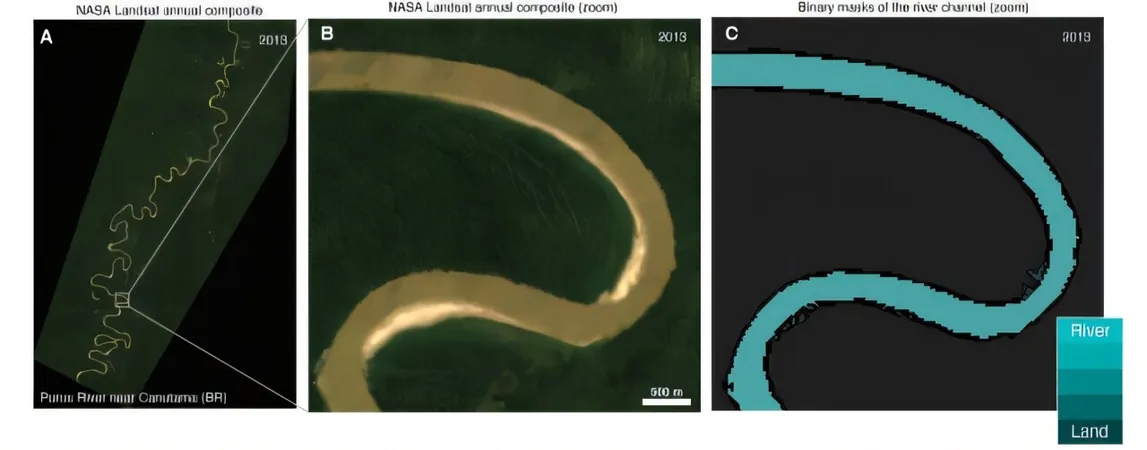
Unlocking the Secrets of Rivers: How Erosion Shapes Their Paths and What It Means for Flood Management
2025-07-11
Author: Jacques
Rivers: The Vital Arteries of Our Planet
Rivers act as the lifeblood of Earth, carrying water, sediment, and nutrients from the mountains to the oceans. They create a complex tapestry of waterways—some maintaining a single channel, while others sprawl into a network of interconnected paths. These formations are critical, influencing flood risks, erosion threats, and the ecosystem services that billions depend on.
A Century-Old Mystery Solved
For over a hundred years, scientists have grappled with why some rivers form single channels while others split into multiple threads. Researchers at UC Santa Barbara recently made a groundbreaking discovery by mapping the dynamics of 84 rivers over 36 years using satellite imagery. They found that rivers create multiple channels when bank erosion outpaces the deposition of sediment on the opposite banks. This finding has the potential to change flood risk assessments and river restoration strategies.
Understanding the Two Faces of Rivers
Traditionally, geographers classify rivers into single-channel and multi-channel types, often studying them in isolation. While no clear majority exists, many of the world's largest rivers fall into the multi-channel category—an exception being the well-studied Mississippi River. Much of the fieldwork has been historically skewed towards single-channel rivers due to their simpler nature.
A Sparks of Curiosity in a Laboratory Setting
Lead researcher Austin Chadwick's journey began during laboratory experiments at the University of Minnesota. As he examined multi-channel rivers, he observed them constantly widening and splitting—a phenomenon that defied conventional wisdom. This inspired him to explore whether this erosion pattern was also evident in natural settings.
Decoding River Dynamics Using Satellite Data
Utilizing data from Landsat images via Google Earth Engine, the research team meticulously tracked erosion and deposition across various riverbanks. They employed cutting-edge image-processing algorithms to analyze satellite imagery, revealing that while single-threaded rivers maintain a consistent width through balanced erosion and deposition, multi-channel rivers constantly change and realign as erosion dominates.
The Impact of Human Intervention
Throughout the 20th century, many rivers have been confined to narrow channels, disconnected from their natural floodplains—a move fueled by urban development and flood control efforts. This disconnect harms ecosystems and can elevate flood risks, as sediment builds up in the riverbed, making the water more prone to overflow during heavy rains. Historical examples, such as the flooding in Hurricane Katrina, illustrate the dangers of restricting rivers.
Reconnecting Rivers to Their Floodplains
There’s a rising movement to restore rivers to their original channels by reconnecting them with floodplains. The insights from this research now enable scientists and engineers to assess how much space a river needs to return to its natural state, expediting restoration projects and minimizing costs.
A Transformative Model for River Restoration
The research introduced a formula that helps estimate the necessary width and time for rivers to recover their multi-threaded configurations. Remarkably, it was discovered that restoring single-threaded rivers demands ten times more space and time compared to restoring rivers that already flow with multiple channels.
Implications for Future Projects and Climate Change
The findings could reshape how we approach infrastructure and environmental conservation. This research indicates that projects focusing on multi-threaded rivers might be more cost-effective and beneficial than previously thought, especially considering many single-threaded rivers were once multi-threaded before human alteration.
The Ongoing Quest for Knowledge
Chadwick and his team continue to delve into the complexities of river dynamics, exploring climate change’s impact on these water systems. As they investigate how rivers interact with human activities and the natural environment, their mission remains clear: unlocking the secrets of rivers for better coexistence and flood management in an ever-changing world.









 Brasil (PT)
Brasil (PT)
 Canada (EN)
Canada (EN)
 Chile (ES)
Chile (ES)
 Česko (CS)
Česko (CS)
 대한민국 (KO)
대한민국 (KO)
 España (ES)
España (ES)
 France (FR)
France (FR)
 Hong Kong (EN)
Hong Kong (EN)
 Italia (IT)
Italia (IT)
 日本 (JA)
日本 (JA)
 Magyarország (HU)
Magyarország (HU)
 Norge (NO)
Norge (NO)
 Polska (PL)
Polska (PL)
 Schweiz (DE)
Schweiz (DE)
 Singapore (EN)
Singapore (EN)
 Sverige (SV)
Sverige (SV)
 Suomi (FI)
Suomi (FI)
 Türkiye (TR)
Türkiye (TR)
 الإمارات العربية المتحدة (AR)
الإمارات العربية المتحدة (AR)